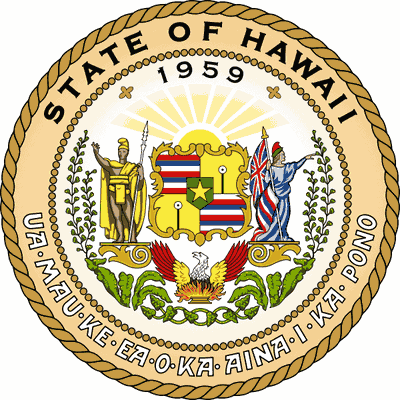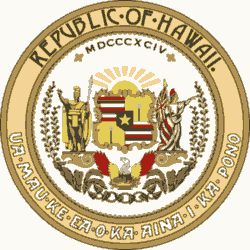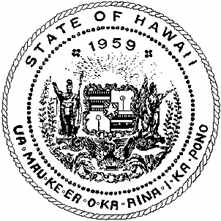

Hawaii Symbols
- » 50 States
- » Histories
- » State Symbols
- » Seals
Hawaii State Seal
Great Seal of the State of Hawaii

Adopted in 1959.
The Great Seal of the State of Hawaii was designated officially by Act 272 of the 1959 Territorial Legislature and is based on the territorial seal. Modifications to the territorial seal included the use of the words "State of Hawaii" at the top and "1959" within the circle. Provisions for a seal for the state of Hawaii was enacted by the Territorial Legislator and approved by Governor William F. Quinn on June 8, 1959. The passage of the Admission Act in 1959, admitted Hawaii as the 50th State of the United States of America on August 21, 1959.
The regal crown was replaced by the sun and the year 1959, which was when Hawaii officially became a state. The star in the center of the shield replaced canoe paddles crossed against a sail. The seal was originally designed by Viggo Jacobsen for the then-Republic of Hawaii in 1895. The seal is a modified version of the royal coat of arms of the Hawaiian kingdom. Where the royal seal had two warriors, the state seal has King Kamehameha the Great on one side and the Goddess of Liberty on the other holding the Hawaiian flag.
The Phoenix below the shield is new. In other places, emblems or royalty were replaced by emblems symbolic of a new Hawaii.
Hawaii Great Seal
The seal of the state of Hawaii hangs from the mauka and makai entrances to the state capitol, and is patterned after the royal coat of arms of the Kingdom of Hawaii. From the March/April 1979 issue of Aloha Magazine*, the symbolism of the seal is described:
- 1959 represents the date of statehood.
- The rising sun replaces the royal crown and Maltese cross of the original coat of arms, and signifies the birth of a new state.
- King Kamehameha the Great and Goddess of Liberty holding teh Hawaiian flag replace the two warriors on the royal coat of arms.
- The quartered design of the heraldic shield is retained from the coat of arms.
- The four stripes of the Hawaiian flag in each of the first and fourth quarters represent the eight islands.
- Puloulou, or tabu ball and stick, in the second and third quarters was carried before the king and placed before the door of his home, signifying his authority and power. Here, it is a symbol of the authority and power of government.
- The star represents the fiftieth star added to the national flag when Hawaii became a state.
- The phoenix, symbol of death and resurrection, symbolizes the change from the monarchy to a freer democratic form of government.
- The eight taro leaves, flanked by banana foliage and maidenhair fern are typical Hawaiian flora. Taro was the staff of life and had great religious significance.
- The state motto "Ua mau ke ea o ka aina i ka pono", "The life of the land is perpetuated in righteousness" is retained from the royal coat of arms.
Seal of the Territory of Hawai'i 1901
The seal of the Territory of Hawai'i was the same as the seal of the republic, except that it had "Territory of Hawaii" placed at the top and "1900" (signifying the year that the territorial government officially was organized) within the circle. The 1901 Territorial Legislature authorized the modified republic seal as the Seal of the Territory of Hawaii.
Seal of the Republic of Hawai'i 1845
 The seal
of the Republic of Hawai'i had the words "Republic of Hawaii" at the top and "MDCCCXCIV" within the circle. The year 1894
signified the date that the republic was established. The republic seal was designed by Viggo Jacobsen, a Honolulu resident, and itself was derived
from the Kingdom of Hawai'i coat of arms used during the reign of King Kamehameha III, King Kalakaua and Queen Lili'uokalani, which had been designed
by the College of Arms in London in 1842 and officially adopted in 1845
The seal
of the Republic of Hawai'i had the words "Republic of Hawaii" at the top and "MDCCCXCIV" within the circle. The year 1894
signified the date that the republic was established. The republic seal was designed by Viggo Jacobsen, a Honolulu resident, and itself was derived
from the Kingdom of Hawai'i coat of arms used during the reign of King Kamehameha III, King Kalakaua and Queen Lili'uokalani, which had been designed
by the College of Arms in London in 1842 and officially adopted in 1845
Hawai'i Law
Hawai`i Revised Statutes, Volume 1, Chapter 5, Section 5-5.
Volume 1.
CHAPTER 5. EMBLEMS AND SYMBOLS.
SECTION 5-5.
§5-5 State seal, description. The great seal of the State shall be circular in shape, two and three-quarters inches in diameter, and
of the design being described, with the tinctures added as a basis for the coat of arms as follows:
Arms. An heraldic shield which is quarterly; first and fourth, stripes of the Hawaiian flag; second and third, on a yellow field,
a white ball pierced on a black staff; overall, a green escutcheon with a five-pointed yellow star in the center.
Supporters. On the right side, Kamehameha I, standing in the attitude as represented by the bronze statue in front of Aliiolani Hale,
Honolulu; cloak and helmet yellow; figure in natural colors. To the left, goddess of liberty, wearing a Phrygian cap and laurel wreath, and holding
in right hand the Hawaiian flag, partly unfurled.
Crest. A rising sun irradiated in gold, surrounded by a legend "State of Hawaii, 1959," on a scroll, black lettering.
Motto. "Ua mau ke ea o ka aina i ka pono" on the scroll at bottom, gold lettering.
Further accessories. Below the shield, the bird phoenix wings outstretched; arising from flames, body black, wings half yellow, half dark red; also
eight taro leaves, having on either side banana foliage and sprays of maiden hair fern, trailed upwards. [L 1901, c 16, §1; RL 1925, §143; RL 1935,
?7771; RL 1945, §12941; RL 1955, §14-5; am L 1957, c 29, §1; am L 1959, c 272,
§2; HRS §5-5]
Note
The seal is the same as that of the Republic of Hawaii, except that the latter was three inches in diameter and had the legend "Republic of Hawaii."
See L 1896, p 272, joint resolution; CL §24.

Great Seal of the STATE OF HAWAII
§5-6 Seal; commercial use. Whoever uses any representation of the great seal or the coat of arms of the State in any advertisement or for any
commercial purpose or in any manner likely to give the impression of official State approval shall be guilty of a misdemeanor. The preceding sentence
shall not be construed to apply to the use of the seal or the coat of arms in any newspaper, periodical, book or pamphlet wherein the seal or coat
of arms is printed for informational purposes only. [L 1967, c 86, §1; HRS §5-6]






